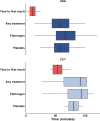Correction of Trauma-induced Coagulopathy by Goal-directed Therapy: A Secondary Analysis of the ITACTIC Trial
- PMID: 39115454
- PMCID: PMC11462890
- DOI: 10.1097/ALN.0000000000005183
Correction of Trauma-induced Coagulopathy by Goal-directed Therapy: A Secondary Analysis of the ITACTIC Trial
Abstract
Background: Trauma hemorrhage induces a coagulopathy with a high associated mortality rate. The Implementing Treatment Algorithms for the Correction of Trauma Induced Coagulopathy (ITACTIC) randomized trial tested two goal-directed treatment algorithms for coagulation management: one guided by conventional coagulation tests and one by viscoelastic hemostatic assays (viscoelastic). The lack of a difference in 28-day mortality led the authors to hypothesize that coagulopathic patients received insufficient treatment to correct coagulopathy.
Methods: During ITACTIC, two sites were coenrolling patients into an ongoing prospective observational study, which included serial blood sampling at the same intervals as in ITACTIC. The subgroup in both studies had conventional and viscoelastic test results for each patient available for analysis. A goal-directed treatment was defined as one triggered by an ITACTIC algorithm. Coagulopathy was defined as rotational thromboelastometry EXTEM A5 less than 40 mm. The primary outcome was correction of coagulopathy by the 12th unit of erythrocyte transfusion during resuscitation.
Results: Full viscoelastic and conventional coagulation test results were available for 133 patients. Of these patients, 71% were coagulopathic on admission, and 16% developed a coagulopathy during resuscitation. ITACTIC viscoelastic hemostatic assay group patients were more likely to receive goal-directed treatment than the standard group (76% vs. 47%; odds ratio, 3.73; 95% CI, 1.64 to 8.49; P = 0.002). However, only 54% of patients received goal-directed treatment, and only 20% corrected their coagulopathy (vs. 0% with empiric treatment alone; not significant). Median time to first goal-directed treatment was 68 (53 to 88) min for viscoelastic and 110 (77 to 123) min for standard (P = 0.005).
Conclusions: In ITACTIC, many bleeding trauma patients did not receive an indicated goal-directed treatment. Interventions arrived late during resuscitation and were only partially effective at correcting coagulopathy.
Copyright © 2024 The Author(s). Published by Wolters Kluwer Health, Inc., on behalf of the American Society of Anesthesiologists.
Conflict of interest statement
Dr. Curry has received research grants from CSL Behring (King of Prussia, Pennsylvania) and Sobi (Stockholm, Sweden) and has served on advisory boards for LFB Biomedicaments (Les Ulis, France), Octapharma (Lachen, Swittzerland), and Sobi. Dr. Maegele has received honoraria for lectures and speakers’ bureaus, congress travel support, and financial support for research projects from Astra Zeneca (Cambridge, United Kingdom), Bayer (Leverkusen, Germany), CSL Behring, Werfen (Barcelona, Spain), LFB Biomedicaments, Octapharma, and Portola Inc. (South San Francisco, California). Dr. Johansson has received unrestricted research grants from Haemonetics Corp. (Boston, Massachusetts) and Octapharma. Dr. Gaarder has received honoraria for lectures from Octapharma, has received research grant support from Haemonetics (Boston, Massachusetts) and Werfen in the form of device and reagent support, and also has previously served on the advisory board for Nycomed (Zurich, Switzerland). Dr. Brohi and Dr. Davenport have received research grant support from Werfen and Haemosonics (Boston, Massachusetts) in the form of device and reagent support and have served on external advisory panels for Octapharma, Astra Zeneca, and Werfen. Dr. Brohi has previously served on external advisory panels for Haemonetics Corp, Werfen, CSL Behring, Bayer, and Astra Zeneca. The other authors declare no competing interests.
Figures





Comment in
- Anesthesiology. 141:10.1097/ALN.0000000000005189.
References
-
- Cole E, Weaver A, Gall L, et al. : A decade of damage control resuscitation: New transfusion practice, new survivors, new directions. Ann Surg 2021; 273:1215–20 - PubMed
-
- Marsden M, Carden R, Navaratne L, Penn-Barwell JG: Outcomes following trauma laparotomy for hypotensive trauma patients: A UK military and civilian perspective. J Trauma Acute Care Surg 2018; 85:620–5 - PubMed
-
- Frith D, Goslings JC, Gaarder C, et al. : Definition and drivers of acute traumatic coagulopathy: Clinical and experimental investigations. J Thromb Haemost 2010; 8:1919–25 - PubMed
-
- Khan S, Brohi K, Chana M, et al. ; International Trauma Research Network (INTRN): Hemostatic resuscitation is neither hemostatic nor resuscitative in trauma hemorrhage. J Trauma Acute Care Surg 2014; 76:561–7 - PubMed
Publication types
MeSH terms
LinkOut - more resources
Full Text Sources
Medical

